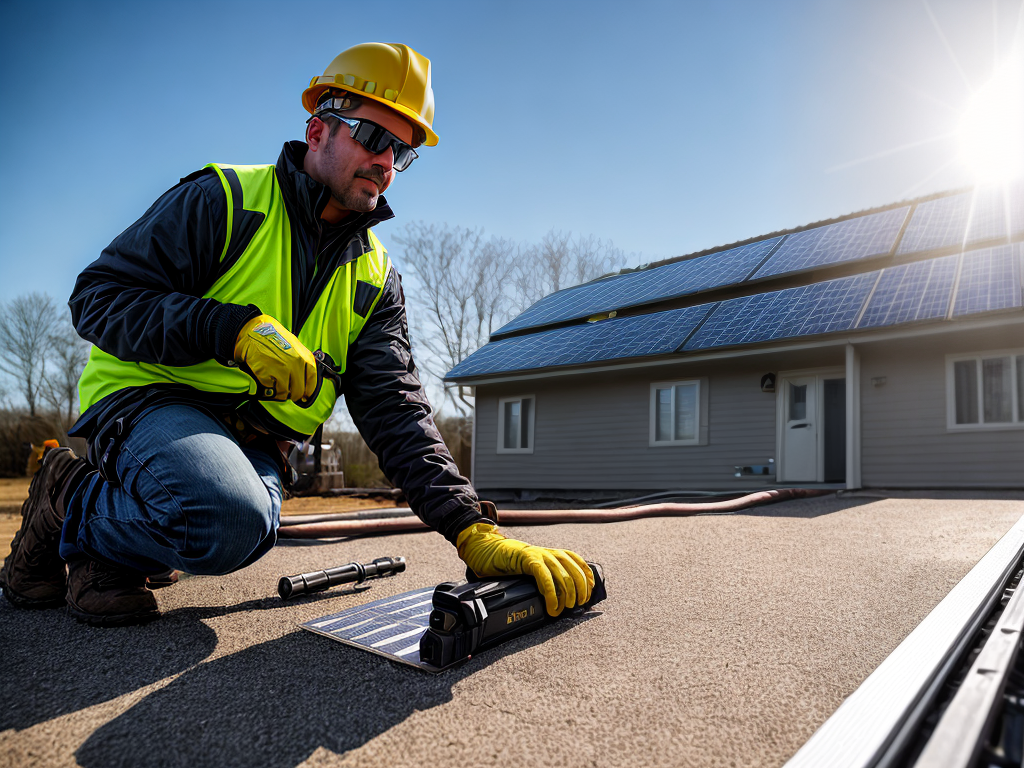
Ever wondered how to harness the power of the sun to generate electricity in your own home? With DIY solar panel installation, you can take the first steps towards a sustainable energy future. From understanding the basics of solar energy to troubleshooting potential issues, this beginner’s guide will equip you with the knowledge needed to embark on your solar journey. So, are you ready to explore the world of solar power and make a lasting impact on both your energy bills and the environment?
Understanding Solar Energy Basics
Understanding solar energy involves harnessing the power of the sun to generate electricity through photovoltaic panels. When considering solar panel efficiency, it is crucial to select panels that can convert a higher percentage of sunlight into usable electricity. Higher efficiency panels typically cost more but can generate more electricity in limited space. Additionally, the orientation of solar panels plays a significant role in their efficiency. For optimal performance, panels should face south in the northern hemisphere or north in the southern hemisphere to receive the most sunlight throughout the day. Proper orientation ensures that panels can capture sunlight most effectively, maximizing energy production. Factors like shading from nearby structures or trees can also impact panel efficiency, so it is essential to consider these aspects when planning your solar panel installation. By understanding solar panel efficiency and proper orientation, you can make informed decisions to maximize the energy output of your solar system.
Assessing Your Home’s Solar Potential
When evaluating solar potential for my home, critical factors include roof sun exposure, shade analysis, and space availability. Understanding how much sunlight your roof receives throughout the day is crucial for determining the efficiency of solar panels. Additionally, assessing any obstructions that may cast shadows on the panels and ensuring sufficient space for installation are essential considerations.
Roof Sun Exposure
Assessing the solar potential of your home begins with evaluating the amount of direct sunlight your roof receives throughout the day. Roof orientation plays a crucial role in determining peak sunlight exposure. For optimal solar energy production, a south-facing roof orientation is ideal in the Northern Hemisphere, while a north-facing orientation is preferred in the Southern Hemisphere. To help you visualize this, consider the following table:
| Time of Day | Sunlight Exposure Level | Recommended Action |
|---|---|---|
| Morning | Low | Monitor shading from obstacles |
| Noon | High | Assess any potential obstructions |
| Afternoon | Moderate | Note any shadows cast |
| Evening | Low | Plan for future tree growth |
Understanding your roof’s sun exposure is fundamental for a successful solar panel installation.
Shade Analysis
To accurately evaluate the solar potential of a home, one must conduct a thorough shade analysis. Shade analysis benefits by providing crucial information on the amount of sunlight reaching different areas of the roof. This assessment is vital for determining the feasibility of installing solar panels and optimizing their efficiency. A shade study is of utmost importance because it helps identify any obstructions such as trees, buildings, or other structures that may cast shadows on the solar panels. By understanding the shading patterns throughout the day and seasons, homeowners can make informed decisions about panel placement to maximize energy production. Conducting a shade analysis is a fundamental step in the process of assessing your home’s suitability for solar panel installation.
Space Availability
In evaluating the space availability for solar panel installation on your home, it is crucial to consider the unobstructed areas that receive direct sunlight throughout the day. To optimize space for solar installation, rooftops are often the ideal location due to their expansive, unshaded surface area. When assessing your home’s solar potential, focus on utilizing rooftops efficiently to maximize solar efficiency. Ensure that the chosen location for solar panel installation is free from shadows cast by nearby trees, buildings, or other obstructions. By strategically placing solar panels on unobstructed rooftops, you can enhance the effectiveness of your solar energy system. This careful consideration of space optimization is essential for achieving the best results from your solar installation.
Selecting the Right Solar Panels
When choosing the right solar panels for your installation, it’s crucial to consider factors like panel size, efficiency, and output. Panel size considerations should align with the available space on your roof or property to maximize energy production. Efficiency and output ratings determine how well the panels convert sunlight into usable electricity, impacting the overall performance of your solar system.
Panel Size Considerations
Considering the optimal size of solar panels plays a crucial role in maximizing energy production and efficiency for your solar panel installation. When selecting the right solar panels, factors such as panel orientation and mounting options are key in determining the overall effectiveness of your system.
- Panel Orientation: Properly aligning your solar panels towards the sun can significantly enhance energy generation.
- Mounting Options: Choosing the right mounting option, whether roof-mounted or ground-mounted, can impact the efficiency and longevity of your solar panel system.
- System Size: Matching the size of your solar panel system to your energy needs ensures that you harness the full potential of solar energy while optimizing cost-effectiveness.
These considerations are essential for creating a solar panel setup that not only meets your energy requirements but also integrates seamlessly into your lifestyle.
Efficiency and Output
To optimize energy production and efficiency for your solar panel installation, it is crucial to carefully select solar panels based on their efficiency and output capabilities. Maximizing efficiency and optimizing output are key factors in ensuring your system generates the most electricity possible. When choosing solar panels, consider the efficiency rating, which indicates how well the panel converts sunlight into electricity. Additionally, look at the power output, measured in watts, to understand how much electricity the panel can produce under standard test conditions. Below is a table outlining some common solar panel types and their efficiency and output specifications:
| Solar Panel Type | Efficiency (%) | Power Output (W) |
|---|---|---|
| Monocrystalline | 15-22 | 320-400 |
| Polycrystalline | 13-18 | 270-350 |
| Thin-Film | 10-15 | 150-250 |
Planning Your Solar Panel Layout
I typically recommend starting the process of planning your solar panel layout by assessing your available roof space and orientation. This initial step is crucial for optimizing your layout to maximize energy production. Consider the following points to guide your decision-making process:
- Layout Optimization: Efficiently utilizing your roof space is key to enhancing the energy output of your solar panels.
- Aesthetics: Ensuring that the solar panels are aesthetically pleasing can enhance the overall look of your property.
- Panel Placement: Strategically placing the panels to receive maximum sunlight exposure throughout the day is essential for optimal energy generation.
Installing Solar Panels Safely
Assessing the structural integrity of your roof and ensuring proper equipment and safety measures are in place is paramount when installing solar panels safely. Before beginning the installation process, it’s crucial to conduct a thorough inspection of the roof to confirm it can support the weight of the solar panels. Safety precautions must be strictly adhered to throughout the installation to prevent accidents. Prioritize using appropriate safety gear such as harnesses, helmets, and non-slip footwear to minimize any risks.
When it comes to installation techniques, following the manufacturer’s guidelines is essential. Each panel must be securely fastened to the roof using the recommended mounting hardware. Additionally, proper grounding of the solar panels is crucial to ensure electrical safety. Be meticulous in adhering to all electrical codes and guidelines to prevent any electrical hazards. Regularly inspect the panels and electrical connections to identify and address any issues promptly. By prioritizing safety precautions and meticulous installation techniques, you can ensure a safe and effective solar panel installation.
Connecting Solar Panels to Your Home
Connecting solar panels to a home requires careful planning and precise execution to ensure optimal performance and safety. When integrating solar panels into your home’s electrical system, it is crucial to follow proper procedures to prevent accidents and maximize energy efficiency. Here are some key considerations for connecting solar panels:
-
Electrical Wiring: Ensuring the correct gauge of wiring is used and that all connections are secure is vital to prevent overheating or electrical failures.
-
Energy Storage: Implementing a reliable energy storage solution such as batteries can help store excess energy generated by the solar panels for use during periods of low sunlight.
-
Inverter Installation: Installing an inverter that converts direct current (DC) from the solar panels into alternating current (AC) compatible with your home’s electrical system is essential for seamless integration.
Troubleshooting Solar Panel Issues
When troubleshooting solar panel issues, systematically check each component for faults to pinpoint the source of the problem accurately. Common issues with solar panels can include shading, inverter problems, wiring faults, and monitoring system malfunctions. To diagnose these problems, follow these troubleshooting techniques:
| Issue | Troubleshooting Technique |
|---|---|
| Shading | Check for nearby obstructions casting shadows on the panels. Trim trees or reposition panels if necessary. |
| Inverter Problems | Verify the inverter display for error codes. Reset the inverter and check DC and AC connections. |
| Wiring Faults | Inspect wiring for damage or loose connections. Test voltage at various points to identify the faulty section. |
| Monitoring System Issue | Ensure the monitoring system is connected to the internet and receiving data. Check for software updates and reset if needed. |

